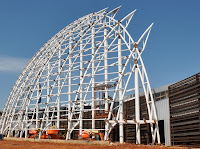The Memorial Coliseum in Corpus Christi was a state-of-the-art venue constructed in September of 1954. At the time, the boasted the world’s longest unsupported span roof at 224 feet using 260 tons of structural steel. After nearly 60 years of service, the coliseum is now set for demolition, but through recycling, parts of this landmark will live on.
When its deconstruction is completed on schedule in August, that same steel that enabled a record-setting unsupported span roof will live on thanks to recycling.
Jerry Shoemaker of RH Shackelford, the Project Manager of the Memorial Coliseum deconstruction and a retired Lieutenant Commander of the U.S. Navy Civil Engineer Corps, says he pushes for recycling on his demolition projects.
“[Recycling materials] is pretty standard since the 90’s,” says Shoemaker. “The processes are down and the vendors that want the materials use it as an opportunity. Ones that do it best are the ones that bid the best.”
In addition to the sustainable benefits of steel and its recyclability, the landfill space not being used is a positive as well. “We encourage, strongly encourage [contractors to recycle], because we also own the landfill. We told them we wouldn’t be accepting steel at the landfill. We’ve limited their opportunities to push them towards that recycling.”
Shoemaker has nearly 30 years of experience in the field and agrees that steel’s ease of recycling is a benefit, “Steel is easier to recycle, easier to pick it up, haul it off, control it and dispose it. Concrete on the other hand has got its challenges. Steel holds the better opportunity.”
With the continued reuse of steel in the industry, it’s become a standard in almost all structures and Shoemaker’s experience confirms that: “I can’t recall any projects that didn’t have some steel, it’s a good material.”
The Memorial Coliseum was uniquely designed by Richard S. Colley, and has been featured in dozens of media outlets, including international publications, for its exceptional construction. Its deconstruction is now receiving media interest for its responsible recycling of steel and other materials.





